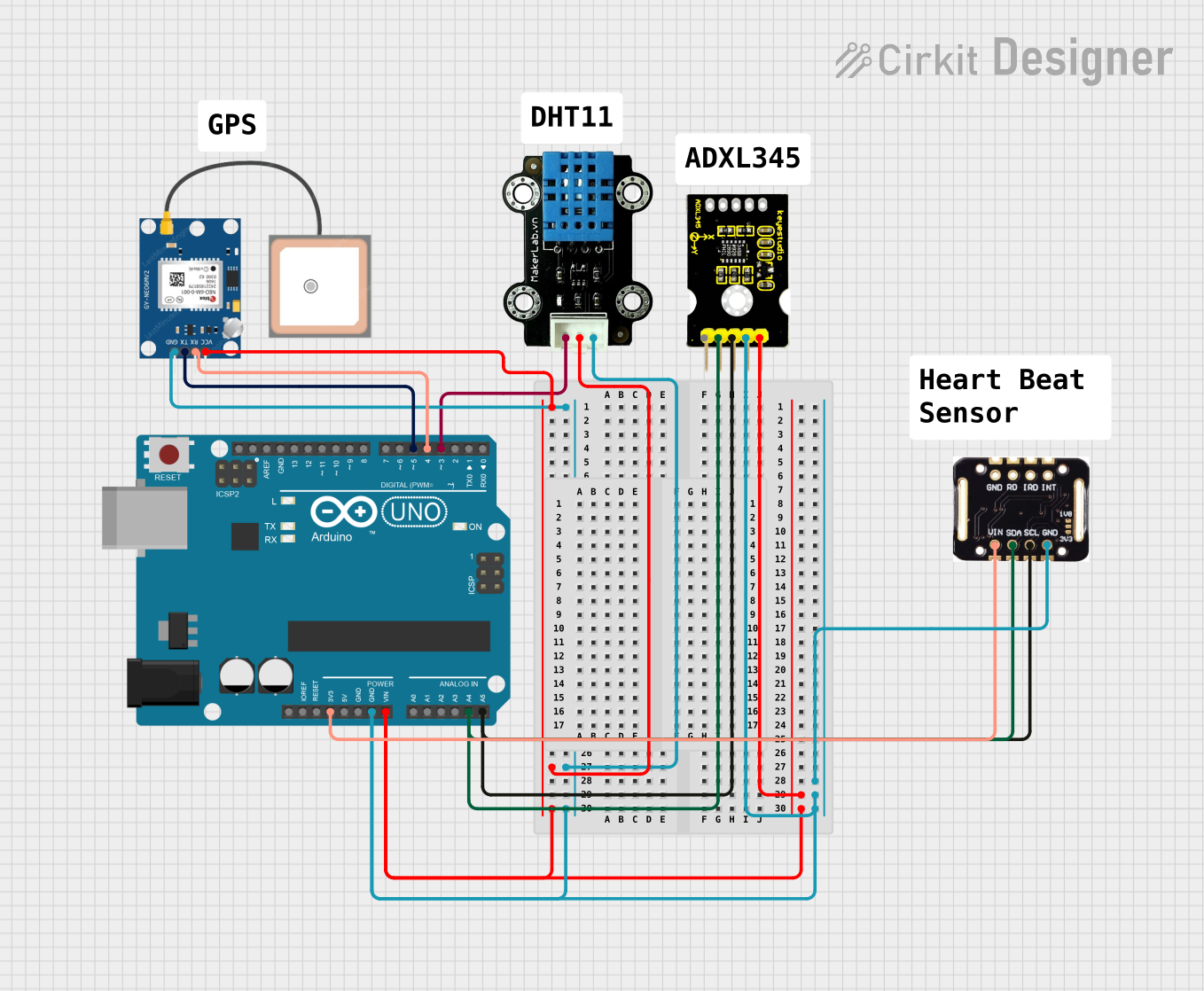
Arduino UNO Based Environmental and Position Tracking System

Circuit Documentation
Summary
The circuit in question is designed around an Arduino UNO microcontroller and includes a GPS NEO 6M module, a MKE-S14 DHT11 Temperature and Humidity Sensor, an ADXL345 accelerometer from Keystudio, and a MAX30102 pulse oximetry and heart-rate sensor. The Arduino UNO serves as the central processing unit, interfacing with the sensors and modules to collect and process data such as location, temperature, humidity, acceleration, and heart rate. The circuit is powered through the Arduino's voltage input pins, and sensor data is communicated to the Arduino via digital and analog pins. The embedded code provided facilitates the initialization and reading of sensor data, which is then output through the Arduino's serial interface.
Component List
Arduino UNO
- Microcontroller board based on the ATmega328P
- Features digital I/O pins, analog input pins, and various power pins
GPS NEO 6M
- GPS module for satellite navigation
- Communicates with the Arduino via serial interface
MKE-S14 DHT11 Temperature and Humidity Sensor
- Sensor for measuring ambient temperature and humidity
- Provides digital signal output to the Arduino
ADXL345 Keystudio
- A digital accelerometer providing motion sensing on three axes
- Uses I2C communication protocol
MAX30102
- Integrated pulse oximetry and heart-rate monitor sensor module
- Uses I2C communication protocol
Wiring Details
Arduino UNO
Vinconnected to the 5V power supply lines of GPS NEO 6M and ADXL345 Keystudio3.3Vconnected to the VIN of MAX30102GNDconnected to the ground lines of all componentsA4 (SDA)connected to the SDA lines of ADXL345 Keystudio and MAX30102A5 (SCL)connected to the SCL lines of ADXL345 Keystudio and MAX30102D3connected to the SIG pin of DHT11 Temperature and Humidity SensorD4connected to the RX pin of GPS NEO 6MD5connected to the TX pin of GPS NEO 6M
GPS NEO 6M
VCCconnected to the 5V power supplyGNDconnected to the groundTXconnected to Arduino's D5RXconnected to Arduino's D4
MKE-S14 DHT11 Temperature and Humidity Sensor
SIGconnected to Arduino's D35Vconnected to the 5V power supplyGNDconnected to the ground
ADXL345 Keystudio
5Vconnected to the 5V power supplyGNDconnected to the groundSDAconnected to Arduino's A4SCLconnected to Arduino's A5
MAX30102
VINconnected to Arduino's 3.3VGNDconnected to the groundSDAconnected to Arduino's A4SCLconnected to Arduino's A5
Documented Code
#include <Wire.h>
#include <Adafruit_Sensor.h>
#include <Adafruit_ADXL345_U.h>
#include <DHT.h>
#include <SoftwareSerial.h>
// Pin definitions
#define HEARTBEAT_PIN A0
#define DHT_PIN 3
#define GPS_RX_PIN 4
#define GPS_TX_PIN 5
// DHT11 setup
#define DHTTYPE DHT11
DHT dht(DHT_PIN, DHTTYPE);
// ADXL345 setup
Adafruit_ADXL345_Unified accel = Adafruit_ADXL345_Unified(12345);
// GPS setup
SoftwareSerial gpsSerial(GPS_RX_PIN, GPS_TX_PIN);
void setup() {
Serial.begin(9600);
gpsSerial.begin(9600);
dht.begin();
if (!accel.begin()) {
Serial.println("No ADXL345 detected!");
while (1);
}
Serial.println("Setup complete.");
}
void loop() {
// Read heartbeat sensor
int heartbeat = analogRead(HEARTBEAT_PIN);
Serial.print("Heartbeat: ");
Serial.println(heartbeat);
// Read DHT11 sensor
float h = dht.readHumidity();
float t = dht.readTemperature();
Serial.print("Humidity: ");
Serial.print(h);
Serial.print(" %\t");
Serial.print("Temperature: ");
Serial.print(t);
Serial.println(" *C");
// Read ADXL345 sensor
sensors_event_t event;
accel.getEvent(&event);
Serial.print("X: ");
Serial.print(event.acceleration.x);
Serial.print(" \tY: ");
Serial.print(event.acceleration.y);
Serial.print(" \tZ: ");
Serial.print(event.acceleration.z);
Serial.println(" m/s^2");
// Read GPS data
while (gpsSerial.available()) {
char c = gpsSerial.read();
Serial.print(c);
}
delay(2000); // Delay for 2 seconds
}
This code initializes and reads data from the connected sensors, then outputs the readings through the Arduino's serial port. It includes setup and loop functions, which are standard in Arduino programming. The setup function initializes the serial communication, sensors, and checks for the presence of the ADXL345 accelerometer. The loop function reads data from the heartbeat sensor, DHT11, ADXL345, and GPS module, then prints the values to the serial monitor.